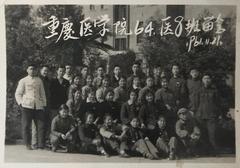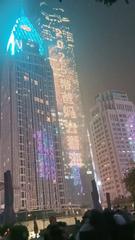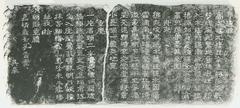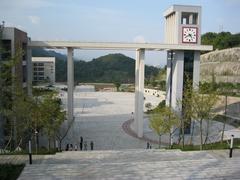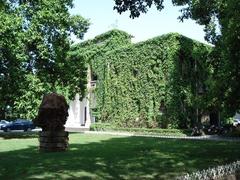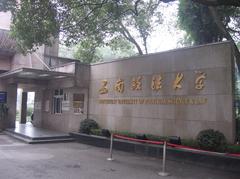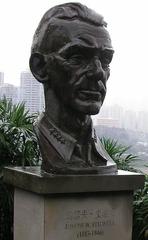Shizhuanshan Cliffside Carvings: Visiting Hours, Tickets, and Guide to Chongqing Historical Sites
Date: 04/07/2025
Introduction
The Shizhuanshan Cliffside Carvings, located within Chongqing’s Dazu District, are a remarkable testament to China’s religious syncretism and artistic heritage. As an integral component of the famed Dazu Rock Carvings—designated a UNESCO World Heritage Site—Shizhuanshan encapsulates the harmonious coexistence of Buddhism, Taoism, and Confucianism. These intricate carvings, etched into sandstone cliffs, provide an immersive journey through China’s spiritual, social, and artistic traditions from the Tang and Song dynasties to the present. This guide delivers comprehensive information on Shizhuanshan’s history, artistic features, ticketing, visiting hours, accessibility, and practical tips to ensure a rewarding experience at one of Chongqing’s most significant historical sites.
For detailed context and visitor information, see resources such as Dazu Rock Carvings - Wikipedia, China Daily, and Visit Our China.
Table of Contents
- Historical Origins and Cultural Context
- Artistic and Religious Significance
- Site Layout and Major Features
- Conservation and Preservation
- Visiting Information: Hours, Tickets, and Access
- Visitor Experience and Practical Tips
- Visuals, Media, and Further Resources
- Frequently Asked Questions (FAQ)
- Conclusion
- Sources and Further Reading
Historical Origins and Cultural Context
Shizhuanshan is one of five principal sites comprising the Dazu Rock Carvings. The tradition began during the Tang dynasty (7th century CE) and flourished in the Five Dynasties, Song, and later periods. The site’s development was influenced by the region’s role as a crossroads for trade and cultural exchange, integrating motifs from Central China, the Silk Road, and indigenous Ba-Shu traditions (UNESCO, China Daily).
The carvings represent the collaborative efforts of local officials, monks, artisans, and community donors, as documented in numerous inscriptions. This collective patronage fostered an environment where Buddhist, Taoist, and Confucian imagery could coexist, reflecting the social customs and religious beliefs of the Song dynasty and beyond.
Artistic and Religious Significance
Iconography and Themes
Shizhuanshan is celebrated for its unique integration of Buddhist, Taoist, and Confucian figures—a rarity among Chinese grottoes. Notable highlights include:
- Confucian Cave: Statues of Confucius and his disciples, exemplifying the inclusion of Confucian philosophy in religious art.
- Buddhist and Taoist Niches: Images of Sakyamuni, Guanyin (Avalokitesvara), bodhisattvas, and Taoist immortals, often in narrative sequences.
- Secular and Folk Elements: Indigenous motifs, stylized dragons, phoenixes, and depictions of daily life illuminate local customs and beliefs.
The carvings are accompanied by extensive inscriptions—over 100,000 characters—providing insight into the historical context, donors, and teachings (China Tripedia, China.org.cn).
Artistic Techniques
Artisans employed chiseling, incising, and low-relief sculpting directly into the sandstone cliffs. Many works retain traces of original pigments, once used to enhance their visual and spiritual impact. The site’s spatial organization and narrative reliefs reflect a sophisticated approach to visual storytelling (Chongqing Cultural Heritage Bureau).
Site Layout and Major Features
Shizhuanshan includes nine grottoes and more than 500 statues, arranged along a compact cliff face overlooking the Wu River. The largest figures reach up to 3 meters in height, while smaller panels guide visitors through philosophical and spiritual lessons. The layout is designed for contemplative exploration, with natural rock formations integrated into the artistic compositions (Chongqing Municipal Government).
Conservation and Preservation
Legal Framework and Monitoring
Shizhuanshan is protected by national and municipal regulations, including the Law on the Protection of Cultural Relics and local conservation ordinances (State Administration of Cultural Heritage). Scientific monitoring systems track environmental factors such as humidity and temperature, while ongoing maintenance addresses weathering and biological threats.
International Collaboration and Digital Documentation
Major conservation projects involve international experts and digital documentation efforts, such as the “Complete Works of Dazu Rock Carvings,” which provides high-resolution images and mapping data (iChongqing). The 2023 International Forum on Cave Temple Conservation produced the “Dazu Declaration,” focusing on climate change mitigation (GMW.cn).
Visiting Information: Hours, Tickets, and Access
Location
- Address: Fohui Village, Sanqu Town, Dazu District, Chongqing
- Distance: 120–167 km northwest of Chongqing city center (China Tripedia).
Hours
- Open daily: 8:30 AM – 6:00 PM (last entry 5:30 PM), year-round (Visit Our China).
Tickets
- Pricing: 20–50 RMB for Shizhuanshan alone; 120–180 RMB for combination tickets covering main Dazu sites (prices vary by season).
- Purchase: Onsite or online via official platforms; combined tickets recommended for broader exploration.
- Discounts: Available for students, seniors, and groups (Visit Our China).
Getting There
- From Chongqing: Long-distance coaches from Caiyuanba or Chenjiaping stations (3 hours, ~50 RMB); local bus/taxi to Fohui Village.
- From Chengdu: Coaches from Hehuachi Station with a transfer at Dazu.
- By Car: Private hire or taxi offers flexible travel, ideal for multiple site visits (China Tripedia).
Accessibility
- Terrain: Uneven stone paths and steps; not wheelchair accessible. Limited facilities at the site.
- Facilities: Basic restrooms near the entrance; main visitor center located at the broader Dazu complex.
Visitor Experience and Practical Tips
- Best Visiting Times: Spring (April–June) and autumn (September–November) offer pleasant weather and fewer crowds (Asia Odyssey Travel).
- Duration: 1–2 hours for Shizhuanshan; a full day if combining with other sites.
- Footwear: Sturdy, non-slip shoes recommended; paths may be slippery when wet.
- Guided Tours: English-speaking guides are rare; book in advance via tour operators (China Discovery).
- Photography: Allowed except for flash, which damages pigments.
- Respectful Conduct: Do not touch carvings or enter restricted areas; maintain quiet and courteous behavior.
- Food and Water: Bring bottled water and snacks; few options nearby.
Visuals, Media, and Further Resources
High-quality images and virtual tours are available via official tourism platforms. Recommended alt text includes: “Confucius statue and disciples at Shizhuanshan Cliffside Carvings,” “Buddhist bodhisattva carved into sandstone cliff at Shizhuanshan,” and “Overview of nine grottoes at Shizhuanshan in Dazu District.”
Explore related articles:
Frequently Asked Questions (FAQ)
Q: What are the visiting hours for Shizhuanshan Cliffside Carvings?
A: Open daily from 8:30 AM to 6:00 PM; last entry at 5:30 PM.
Q: How do I buy tickets?
A: Purchase onsite or online; combination tickets available for multiple Dazu sites.
Q: Is the site wheelchair accessible?
A: No; paths are uneven with steps.
Q: Are guided tours in English available?
A: Limited; pre-booking via tour agencies is advised.
Q: Can I take photos?
A: Yes, but avoid flash.
Q: What other attractions can I visit nearby?
A: Dazu Rock Carvings, Wu River Scenic Area, and Fuling Old Town.
Conclusion
The Shizhuanshan Cliffside Carvings offer a profound experience for visitors seeking to explore China’s layered religious and artistic history. Their preservation, enhanced by scientific monitoring and international cooperation, ensures that future generations will continue to appreciate their unique beauty. Plan your visit during optimal seasons, consider combination tickets for a fuller perspective, and respect the site’s cultural importance. For up-to-date guides, offline maps, and audio tours, download the Audiala app and follow related social media channels.
Sources and Further Reading
- Dazu Rock Carvings - Wikipedia
- China Daily
- UNESCO World Heritage Centre
- Chongqing Cultural Heritage Bureau
- China Tripedia
- Visit Our China
- Asia Society
- China.org.cn
- Chinese Art Research
- Chongqing Municipal Government
- Chongqing Tourism
- iChongqing
- State Administration of Cultural Heritage
- GMW.cn

